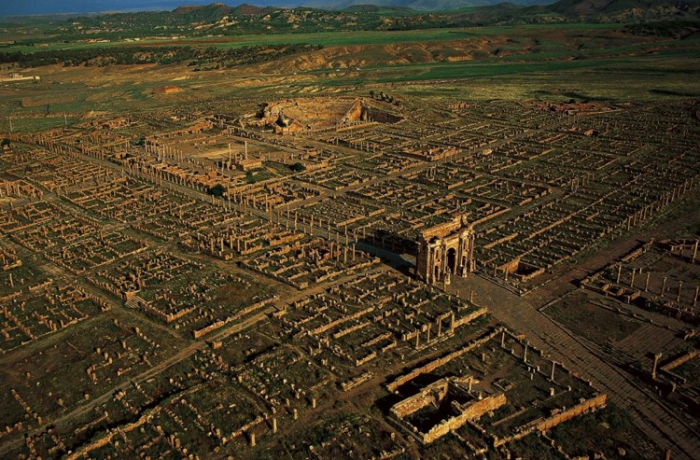Timgad was a Roman colonial town in the Aurès Mountains of Algeria, founded by the Emperor Trajan around AD 100. In the 5th century, the city was sacked by the Vandals before falling into decline. In AD 535 the Byzantine general Solomon found the city empty when he came to occupy it.
In the following century, the city was briefly repopulated as a primarily Christian city before being sacked by Berbers in the 5th century. During the Christian period, Timgad was a bishopric which became renowned at the end of the 4th century when Bishop Optat became the spokesman for the Donatist heresy.
Originally designed for a population of around 15,000, the city quickly outgrew its original specifications and spilled beyond the orthogonal grid in a more loosely organized fashion.
Timgad must have served as a compelling image of the grandeur of Rome on Numidian soil. Buildings, constructed entirely of stone, were frequently restored during the course of the Empire: the Trajan Arch in the middle of the 2nd century, the Eastern gate in 146, and the Western gate under Marcus-Aurelius.
The streets were paved with large rectangular limestone slabs and, as attested by the 14 baths which still may be seen today, particular attention was paid to the disposition of public conveniences.
The houses, of varying sizes, dazzle by their sumptuous mosaics, which were intended to offset the absence of precious marbles. During the Christian period, Timgad was a renowned bishopric. After the Vandal invasion of 430, Timgad was destroyed at the end of the 5th century by montagnards of the Aurès.
The Byzantine Reconquest revived some activities in the city, defended by a fortress built to the south, in 539, reusing blocks removed from Roman monuments. By the mid-2nd century, the rapid growth of the city could no longer be constricted by the narrow confines of its original foundation.
Timgad spread beyond the perimeters of the ramparts, and several major public buildings were constructed in the new quarters to the west and to the south, such as the capitolium, temples, markets and baths.
Most of these buildings date from the Severan period when the city enjoyed its ‘golden age’, which is further attested to by immense private residential buildings such as the House of Sertius or the House of Hermaphrodite.

Timgad was a Roman colonial town in the Aurès Mountains of Algeria
Today the archaeological site is striking for its perfect layout, and includes all the usual elements of a classic Roman settlement – public baths, a library, forum, Capitol, and triumphal arch. The residential part of the town was on a lower level than the capitol and most of the other public buildings.
The ruins of the capitol occupy a prominent position in the southwest of the city. Some of the columns of the façade (which are of the Corinthian order and 45 ft. high) have been re-erected. The dimensions of the capitol correspond with those of the Pantheon at Rome.
Immediately north of the capitol are the remains of a large market; to the east are the ruins of the forum, basilica and theatre. The auditorium of the theatre, which held neatly 4000 persons, is complete.
A little west of the theatre is baths, containing paved and mosaic floors in perfect preservation. Ruins of other and larger thermae are found in all four quarters of the city, those on the north being very extensive.